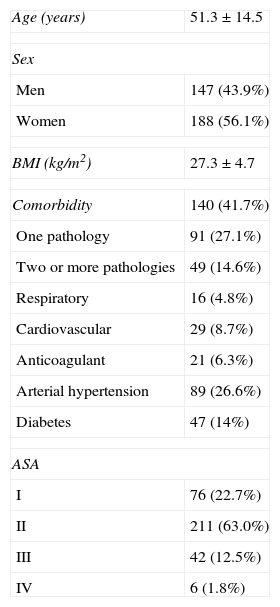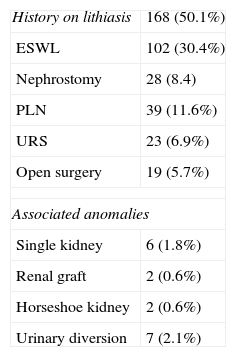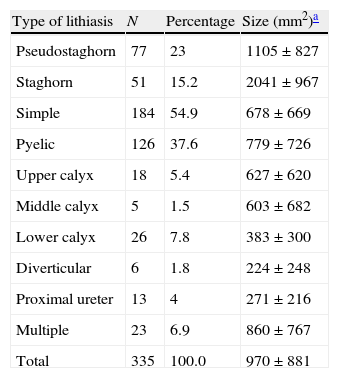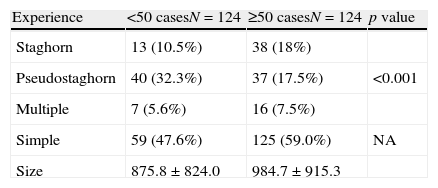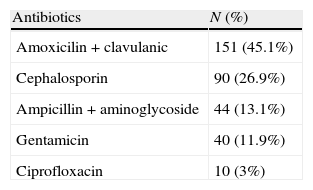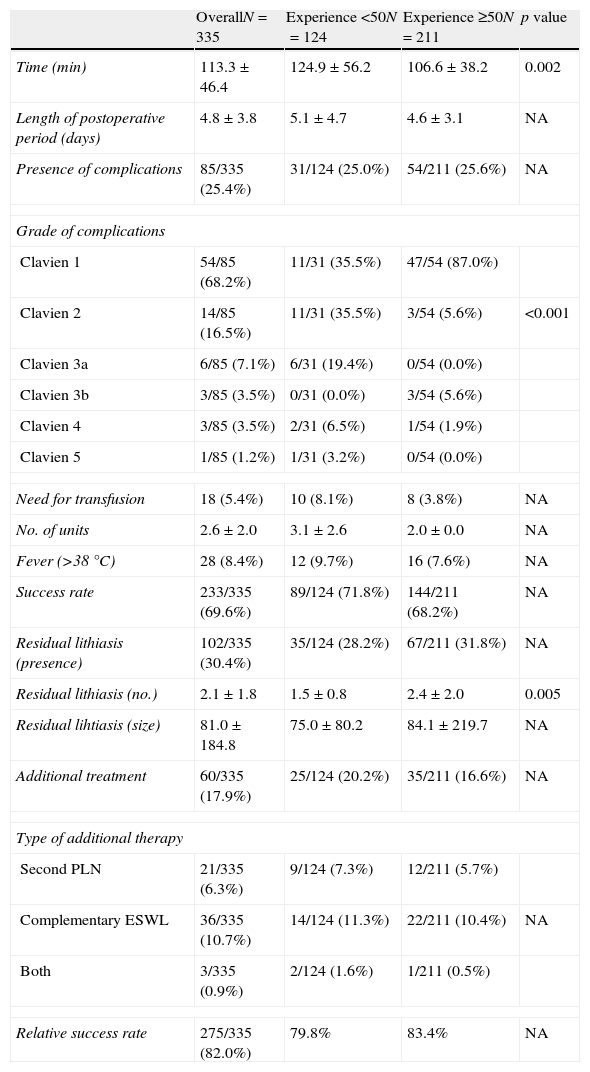To prospectively study the post-operative results and complications of percutaneous nephrolithotomy (PNL) in supine position to assess difficulty of learning it and how experience affects the results. To establish a relative comparison with the data published in the literature on the prone position.
Material and methodsA prospective observational multicenter study on PNL in Valdivia position or in its Galdakao variant was performed. Demographic variables and specific variables related to the lithiasis were collected. Technical aspects, surgery time, success rate and complications according to the Clavien–Dindo classifications were assessed.
ResultsA total of 335 PNL in supine position conducted in 13 Spanish centers were registered from September 2008 to June 2011. The man:woman ratio was 1:1.28 and mean age 51.3±14.5 years. 211 (63%) cases were performed by urologists with experience in ≥50 cases and 124 (37%) by urologists with less experience. Mean operation time was 113.3±46.4min, 106.6±38.2 for the experienced ones vs. 124.9±56.2 in the novice ones (p<0.002). No difference was detected in the mean size of the lithiasis. However, in the experienced group, there was a greater proportion of coraliform cases and multiple lithiasis than in the novice group (p<0.001). Success rate was evaluated, as total absence of lithiasic residuals was 69.6%, without differences between groups (68.2 vs. 71.8%). 102 (30.6%) patients had residual lithiasis and 60 (17,9%) required complementary treatment. Relative global success rate was 82.1% and complications rate 25.4%, without detecting differences between groups. However, the novel group had more major complications (p>0.001).
ConclusionThe PNL in supine position is obtaining rapid and consolidated diffusion in our setting and its effectiveness and safety seem to be equivalent to that described in the literature for PNL in prone position. It is possible to obtain good results with a modest learning curve. The rate of greater complications associated to the procedure decreases with experience.
Estudiar prospectivamente los resultados operatorios y las complicaciones de la nefrolitectomía percutánea (NLP) en posición supina para valorar la dificultad de su aprendizaje y cómo afecta la experiencia a los resultados. Establecer una comparación relativa con los datos publicados en la literatura acerca de la posición en prono.
Material y métodosEstudio prospectivo observacional multicéntrico sobre NLP en posición de Valdivia o en su variante de Galdácano. Se recogen variables demográficas y variables específicas dependientes de la litiasis. Se valoran aspectos técnicos, tiempo quirúrgico, tasa de éxito y complicaciones según la clasificación de Clavien-Dindo.
ResultadosDesde septiembre de 2008 a junio de 2011 se han registrado 335 NLP en posición supina realizadas en 13 centros españoles. La proporción hombre/mujer fue 1:1,28 y la edad media 51,3±14,5 años; 211 (63%) casos fueron realizados por urólogos con experiencia de ≥50 casos y 124 (37%) por urólogos con menos experiencia. El tiempo operatorio medio fue 113,3±46,4min, 106,6±38,2 en experimentados vs. 124,9±56,2 en noveles (p<0,002). No se detectó diferencia en el tamaño medio de la litiasis, pero en el grupo con experiencia se trató una mayor proporción de casos coraliformes y de litiasis múltiples que en el grupo novel (p<0,001). La tasa de éxito evaluada como ausencia total de restos litiásicos fue 69,6%, sin diferencias entre grupos (68,2 vs. 71,8%). En 102 (30,6%) pacientes hubo litiasis residual, precisando tratamiento complementario 60 (17,9%). La tasa relativa de éxito global fue 82,1% y la tasa de complicaciones 25,4%, sin detectarse diferencias entre grupos. No obstante, el grupo novel presentó mayor número de complicaciones mayores (p>0,001).
ConclusiónLa NLP en supino está teniendo una rápida y consolidada difusión en nuestro entorno, y su efectividad y seguridad parece equivalente a la descrita en la literatura para la NLP en prono. Resulta posible conseguir buenos resultados con una modesta curva de aprendizaje. La tasa de complicaciones mayores asociadas al procedimiento disminuye con la experiencia.





